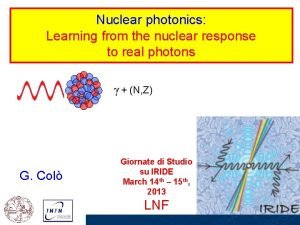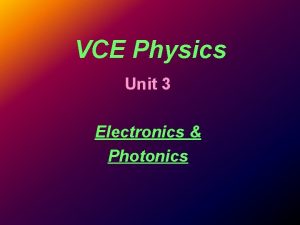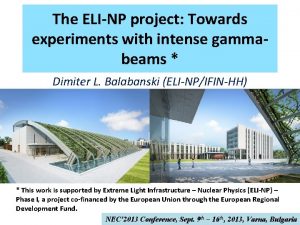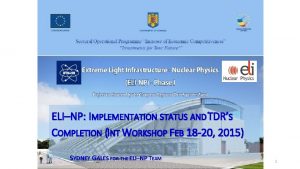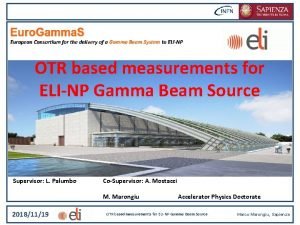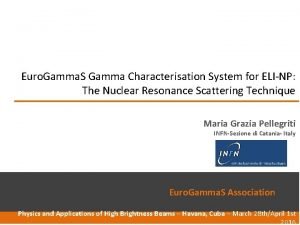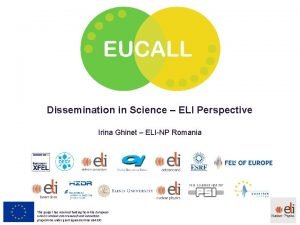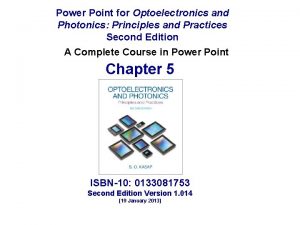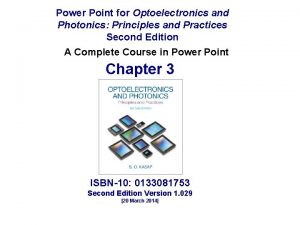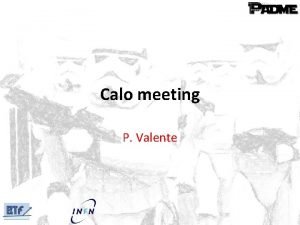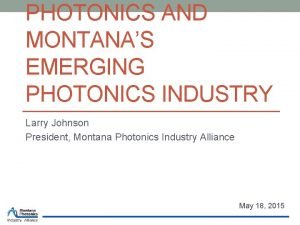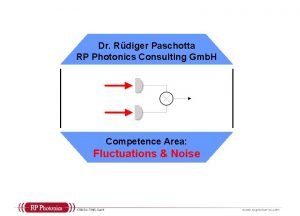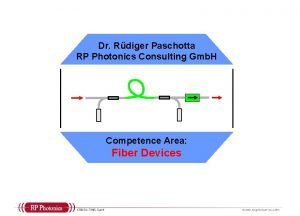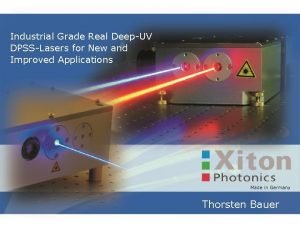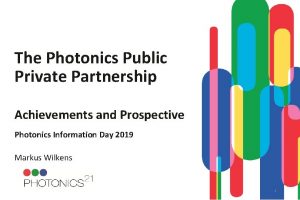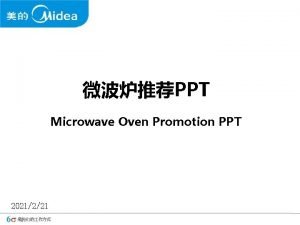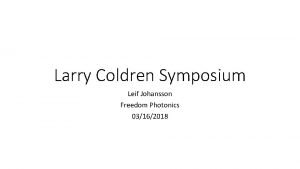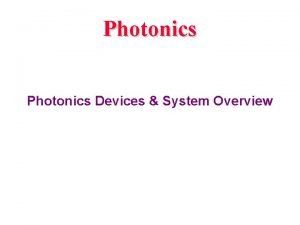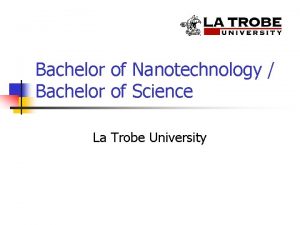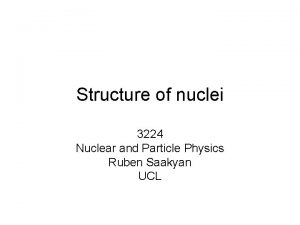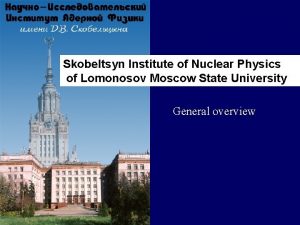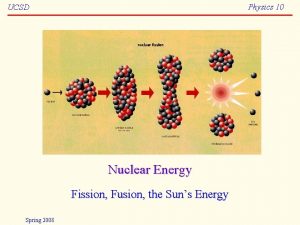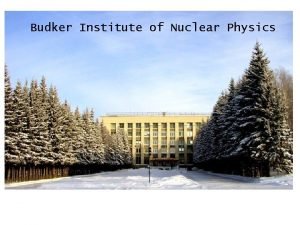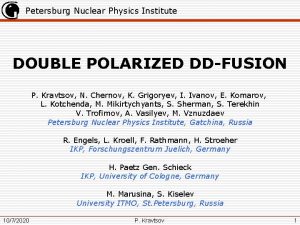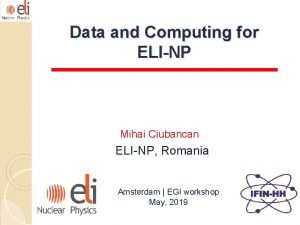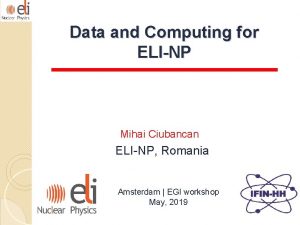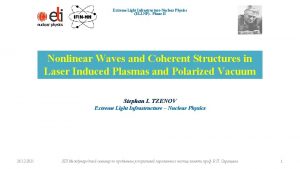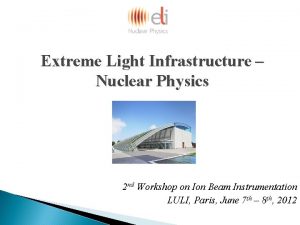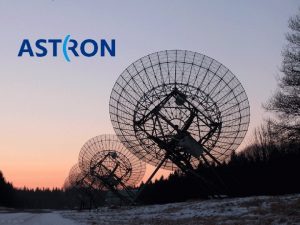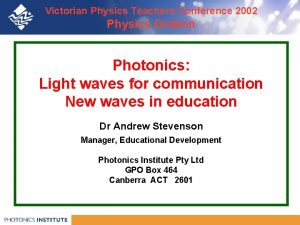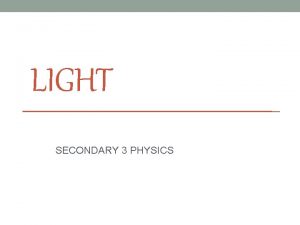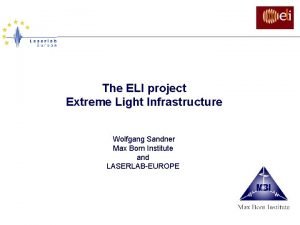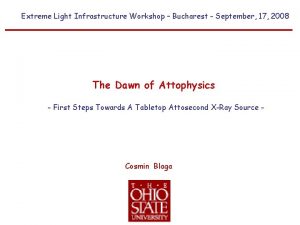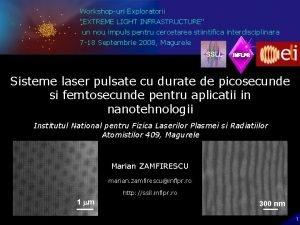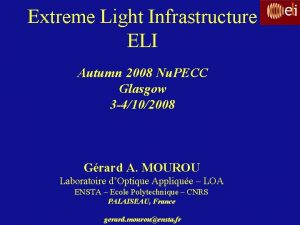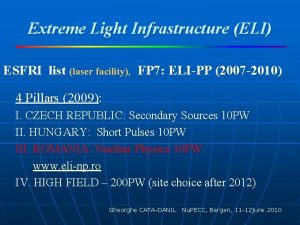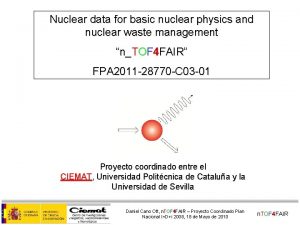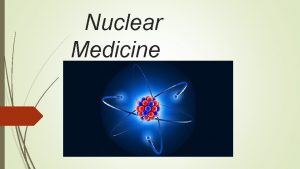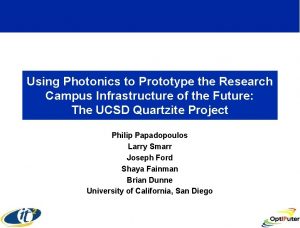Extreme Light Infrastructure Nuclear Physics ELINP Nuclear Photonics
































- Slides: 32

Extreme Light Infrastructure Nuclear Physics (ELI-NP): Nuclear Photonics, New Isotopes by Fission-Fusion, and Fundamental Physics D. Habs LMU München • Fakultät f. Physik Max-Planck-Institut f. Quantenoptik Dietrich Habs NUSTAR, Bucharest, Oct 21, 2011, 10: 40 h 1

Outline Ø Nuclear Photonics • • • Ø New nuclear physics with the APOLLON laser • • Ø From TNSA to light pressure acceleration of ions Fission fusion and the N = 126 waiting point of the r-process Fundamental physics = physics of the vacuum • • Dietrich Habs g facilities: ELI-NP, MEGa-Ray, HIg. S, ILL g beam optics: refractive lenses crystal monochromators g diagnostics Nuclear physics and applications: NRF scissors mode Medical isotopes QOC two phonon mode Brilliant neutron source Pygmy dipole mode Medical isotopes giant resonance mode Brilliant high-energy g production and pair creation in vacuum Detection of new elementary particles by high-power lasers NUSTAR, Bucharest, Oct 21, 2011, 10: 40 h 2

Major components of ELI-NP APOLLON laser stand alone g beam stand-alone • 2∙ 10 PW • Emax = 13 Me. V (19 Me. V) • 15 fs • 12 k. Hz • ~ 1/min • ring-down cavity for photons • 1024 W/cm 2 • warm electron linac, 600 Me. V • 2. 5× 1015 V/m • high brilliance (DEg/Eg ≥ 10– 3) • high flux Company: Thales 1 st funding until 2015 2 nd funding 2015 -2020 1 st period: 3 PW Dietrich Habs (I = 1013 s– 1) APOLLON + e beam • Eg ≈ 100– 500 Me. V • ~ 1/min • flux: Ig = 106 / 15 fs • pair creation: 1024 W/cm 2 + 500 Me. V g NUSTAR, Bucharest, Oct 21, 2011, 10: 40 h 3

Layout ELI-NP August 2011 2 x APOLLON g beam + electron beam Dietrich Habs NUSTAR, Bucharest, Oct 21, 2011, 10: 40 h 4

HIg. S Storage ring + cavity Present: Future HIg. S upgrade: Dietrich Habs NUSTAR, Bucharest, Oct 21, 2011, 10: 40 h 5

g beam at ILL reactor via (n, g) reaction 1016 g/s collimators 10 m Area = 1 mm 2 ; q = 100 mrad 107 g/s BW = 10– 6 = Doppler broadening 2 crystal monochromators with BW = 10 -3 Disadvantage: Advantage: Dietrich Habs Fixed g energies, shifted by g recoil high-resolution double crystal spectrometer GAMS, BW = 10 -6, 10 nrad NUSTAR, Bucharest, Oct 21, 2011, 10: 40 h 6

Refractive g lens (I) RL RL = radius of curvature ≈ R = radius of beamlet Well established up to 200 ke. V, cheap, stable to vibrations G. Vaughan et al. , J. Synchr. Rad. 18, 125 (2011). Dietrich Habs NUSTAR, Bucharest, Oct 21, 2011, 10: 40 h 7

Refractive g lens (II) Nanofocusing lenses Lenses made of silicon. Ch. Schroer et al. , APL 82, 1485 (2003). Dietrich Habs NUSTAR, Bucharest, Oct 21, 2011, 10: 40 h 8

Refractive g lens (III) ID 15 – ESRF, Grenoble Up to 250 ke. V g lenses work as predicted. F = 1013 g/s @ 1 mm 2, bandwidth 10– 2 Changing Eg → changing no. of lenses N for fixed focal length G. Vaughan et al. , J. Synchr. Rad. 18, 125 (2011). Dietrich Habs NUSTAR, Bucharest, Oct 21, 2011, 10: 40 h 9

Gamma lenses Index of refraction and absorption nuclear resonance Si nanotechnology exists, extension from 0. 2 Me. V to several Me. V. d measurement at ILL in July 2011. Dietrich Habs NUSTAR, Bucharest, Oct 21, 2011, 10: 40 h 10

Simple g-lens system for MEGa-Ray FWHM = 4. 4 mm xy RL = 2 mm parallel beam source f = 2. 3 m 10 × 2 D circular Lengler lenses RB = 1 mm RL = 0. 3 mm prefocusing system 2. 5 cm Al x y Eg = 477. 6 ke. V 7 Li collimator 1000 × 1 D lenses RB = 30 mm RL = 12 mm 2× 8. 4 cm Si Request: high brilliance, small opening angle Result: dynamic monochromatization, parallel small-diameter beam, reduced intensity for detectors g optics: large length (> 10 m), similar to hard x-rays, we can even get coherent g-ray beams Experiment: Dietrich Habs 478 ke. V ILL, 1. 8 Me. V HIg. S NUSTAR, Bucharest, Oct 21, 2011, 10: 40 h 11

Double crystal monochromator GAMS, ILL Single crystal – resolution is defined by beam divergence: h/L TOO LARGE for e. V resolution ~ 1 mrad FWHM Dietrich Habs ~ 10 nrad Double Crystal Spectrometer: • First Crystal defines beam axis with nrad • Bragg Angle is measured @ second crystal • Resolution is energy independent -6 • Resolution: DE/E NUSTAR, Bucharest, Oct 21, 2011, 10: 40 h ~ 10 12

Performance of GAMS monochromator Diffraction efficiency of a 2. 5 mm Si 220 @ 0. 8 Me. V Energy Resolution of a 2. 5 mm Si 220 @ 1. 1 Me. V 4. 5 e. V @ 1. 1 Me. V Dietrich Habs NUSTAR, Bucharest, Oct 21, 2011, 10: 40 h 22% @ 0. 8 Me. V 13

New g diagnostics 1000 -fold improved resolution Ø Spatial resolution Typical segmented nuclear g detectors (Ge, La. Br 3) have a spatial resolution of ~ 1 mm for 0. 5 Me. V because the Compton electrons have a range of ~ 5 mm. CCD or imaging plates have mm resolution but without g energy measurement. We want to resolve a g beam diameter of ~ 1 mm to 1 nm from our lenses, using mm to nm structured targets with nuclear resonance fluorescence isotopes, e. g. scanning the focal spot for a specific g energy. Ø Energy resolution Usual Ge detectors have 10 -3 energy resolution; nuclear levels have a typical thermal Doppler broadening of 10 -6. We want to measure this with lenses and Laue crystals (ILL, M. Jentschel). The crystal spectrometers have an absolute ~ 10 nrad angular measurement resolution. We want to use g beams with 10 -6 bandwidth with variable energy (ILL, fixed energy). Ø Large background suppression Small BW beams tuned to nuclear resonance show a strong suppression of atomic background like Compton scattering. High intensity is reduced by BW to value tolerable for detectors. Dietrich Habs NUSTAR, Bucharest, Oct 21, 2011, 10: 40 h 14

Applications of nucl. physics Nuclear excitations Dietrich Habs NUSTAR, Bucharest, Oct 21, 2011, 10: 40 h 15

Photonuclear reactions Doorway states Halo isomers Shape isomers Spin isomers Dietrich Habs NUSTAR, Bucharest, Oct 21, 2011, 10: 40 h 16

Nuclear res. fluorescence M 1 scissors mode 1/2– 478 3/2– 7 Li Extension up to 4 Me. V: § 239 Pu and 235 U 237 Np, 241 Am, 243 Am, 244 Cm, 247 Cm § Minor actinides: § Fission fragments: 137 Cs, 129 I, 99 Tc § 7 Li: Li batteries, antidepressiva medication T. Hayakawa et al. , NIM A 621, 695 (2010). Dietrich Habs NUSTAR, Bucharest, Oct 21, 2011, 10: 40 h 17

Doorway state (I) Spin isomers, 2 -phonon resonance E 2 E 1 Strong E 1 excitation from ground state spin. Quadrupole de-excitations to octupole states. 50 new nuclear radioisotopes for therapy and diagnostics. (patent ILL + LMU), HIg. S + ILL GAMS Dietrich Habs NUSTAR, Bucharest, Oct 21, 2011, 10: 40 h 18

Doorway state (II) Halo isomers, pygmy resonance Halo isomers exist. 1019 x more brilliant micro neutron beams. (patent Siemens – LMU). Dietrich Habs NUSTAR, Bucharest, Oct 21, 2011, 10: 40 h 19

Neutron experiments Dietrich Habs NUSTAR, Bucharest, Oct 21, 2011, 10: 40 h 20

Doorway state (III) Shape isomers, lower giant dipole resonance Expected: 100 x stronger E 1 in 2 nd and 3 rd minimum Spectroscopy of transmission resonances in fission g spectroscopy of transmission resonances in 2 nd & 3 rd min. Resonances with strong E 1 will be important for transmutation of minor actinides. Dietrich Habs NUSTAR, Bucharest, Oct 21, 2011, 10: 40 h 21

Medical radioisotopes (II) (g, 2 n) reaction 44 Ti/44 Sc 46 Ti(g, 2 n)44 Ti (60 a) generator Long-lived generator for hospital, Continuous production of 44 Sc 2∙ 511 ke. V + 1157 ke. V Dietrich Habs NUSTAR, Bucharest, Oct 21, 2011, 10: 40 h 22

44 Ti/44 Sc g-PET generator Measure momentum of Compton electron in strongly pixeled detectors Determine direction and position of 1157 ke. V γ PET = Positron Emission Tomography Better resolution, less dose Dietrich Habs NUSTAR, Bucharest, Oct 21, 2011, 10: 40 h 23

Positron source NEPOMUC at reactor FRM II + ELI-NP Ig = 9∙ 1015/s Ie+ = 9∙ 108 s– 1 B = 4∙ 105/(mm 2 mrad 2 e. V s) emod = 3∙ 10 -6 C. Hugenschmidt et al. , NIM A 554, 384 (2005). Ig = 1013/s Ie+ = 3∙ 109 s– 1 B = 2∙ 106/(mm 2 mrad 2 e. V s) emod = 2∙ 10 -3 Dt = 1 -2 ps (pulsed) Switchable polarization W-foil e+ g Self-moderation, negative electron affinity e+ range = 100 mm C. Hugenschmidt, K. Schreckenbach, D. Habs, P. Thirolf, Appl. Phys. B, submitted ar. Xiv: 1103. 0513 v 1 [nucl-ex] Dietrich Habs NUSTAR, Bucharest, Oct 21, 2011, 10: 40 h 24

Laser acceleration schemes Former schemes Ion acceleration TNSA (target-normal sheath acceleration) • Low conversion efficiency • Huge lasers are required S. C. Wilks et al. , Phys. Plasmas 8, 542 (2001). Dietrich Habs NUSTAR, Bucharest, Oct 21, 2011, 10: 40 h 25

New Acceleration Mechanism Radiation Pressure Acceleration (RPA) Optimum ion acceleration ions Optimum electron acceleration electrons for Normalized areal electron density: = dimensionless Normalized vector potential: S. G. Rykovanov et al. , New J. Phys. 10, 113005 (2008). Dietrich Habs O. Klimo et al. , Phys. Rev. ST AB 11, 031301 (2008). NUSTAR, Bucharest, Oct 21, 2011, 10: 40 h 26

Radiation pressure acceleration (RPA) Cold compression of electron sheet. Rectified dipole field between electrons and ions. Neutral bunch of ions + electrons accelerated. Solid-state density: 1024 e cm– 3 Classical bunches: 108 e cm– 3 Very efficient! Dietrich Habs NUSTAR, Bucharest, Oct 21, 2011, 10: 40 h 27

Fission-fusion reaction very neutron-rich nuclei a) Fission H, C, O + Th → FL + FH fission fragments in target 232 Th + 232 Th → fission of beam in F + F L H Reaction of radioactive short-lived light fission fragments of beam + Radioactive short-lived light fission fragments of the target b) Fusion: FL + FL → Dietrich Habs AZ ≈ 18580 nuclei close to N=126 waiting point FL + FH → 232 Th old nuclei FH + FH → unstable NUSTAR, Bucharest, Oct 21, 2011, 10: 40 h 28

Chart of the Nuclides r-process and waiting points Fission-fusion with very dense beams Radioactive targets + radioactive beam • Superheavies: Z = 110, T 1/2 = 109 a ? • recycling of fission fragments ? Dietrich Habs NUSTAR, Bucharest, Oct 21, 2011, 10: 40 h 29

Pair creation Nonperturbative tunneling process For E << ES exponentially strong suppression Dynamically assisted pair creation: R. Schützhold et al. , Phys. Rev. Lett. 101, 130404 (2008) G. V. Dunne et al. , Phys. Rev. D 80, 111301(R) (2009) High field + high g energy: N. B. Narozhny, Zh. Eksp. Teo. Fiz. 54, 676 (1968). Dietrich Habs NUSTAR, Bucharest, Oct 21, 2011, 10: 40 h 30

Hard g + pair production N. Elkina + H. Ruhl Dietrich Habs NUSTAR, Bucharest, Oct 21, 2011, 10: 40 h 31

Fundamental particle Detection with high-power lasers 2 J 2 k. J K. Homma, D. Habs, T. Tajima, ar. Xiv: 1103. 17482 v 2 Dietrich Habs NUSTAR, Bucharest, Oct 21, 2011, 10: 40 h 32
 Nuclear photonics
Nuclear photonics Current divider formula
Current divider formula Mid shot camera angle
Mid shot camera angle Light light light chapter 23
Light light light chapter 23 Into the light chapter 22
Into the light chapter 22 Chapter 22
Chapter 22 Elinp
Elinp Elinp
Elinp Elinp
Elinp Elinp
Elinp Euro gamma
Euro gamma Irina ghinet
Irina ghinet Optoelectronics and photonics chapter 3 solution
Optoelectronics and photonics chapter 3 solution Energy band diagram of p type semiconductor
Energy band diagram of p type semiconductor Hzc photonics
Hzc photonics Montana photonics industry alliance
Montana photonics industry alliance Paschotta
Paschotta Rpphotonics
Rpphotonics Xiton photonics
Xiton photonics Photonics
Photonics Microwave devices ppt
Microwave devices ppt Freedom photonics
Freedom photonics Optoelectronics and photonics
Optoelectronics and photonics Disadvantage of nanotechnology
Disadvantage of nanotechnology Lesson 15 nuclear quest nuclear reactions
Lesson 15 nuclear quest nuclear reactions Fisión nuclear vs fision nuclear
Fisión nuclear vs fision nuclear Quantum and nuclear physics
Quantum and nuclear physics Magic number in nuclear physics
Magic number in nuclear physics Skobeltsyn institute of nuclear physics
Skobeltsyn institute of nuclear physics Nuclear fission
Nuclear fission Scattering cross section in nuclear physics
Scattering cross section in nuclear physics Budker
Budker Petersburg nuclear physics institute
Petersburg nuclear physics institute
